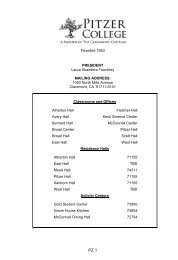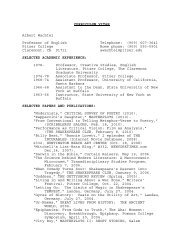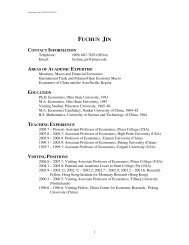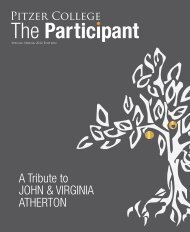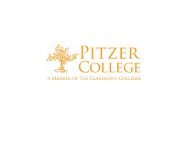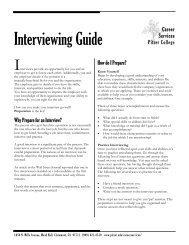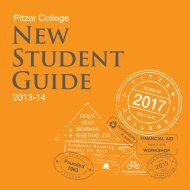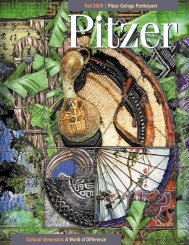You also want an ePaper? Increase the reach of your titles
YUMPU automatically turns print PDFs into web optimized ePapers that Google loves.
62 ART<br />
148. Theories of the Visual. This course examines theories for understanding<br />
relationships between viewers and images through an exploration of the cultural,<br />
political, and psychic mechanisms that accompany the act of looking. It engages these<br />
issues through consideration of painting, photography, film, science, and public space.<br />
Spring, J. Friedlander (Pomona).<br />
150. Chinese Art. Survey of artistic traditions from Neolithic to Modern times.<br />
Architecture, sculpture, painting, calligraphy, ceramics and metal work in their cultural<br />
contexts. B. Coats (Scripps) [not offered <strong>2007</strong>-<strong>08</strong>]<br />
151. The Arts of Japan. The development of Japanese art and civilization from the<br />
Prehistoric through the Meiji periods. Major art forms examined in their cultural context.<br />
Fall, B. Coats (Scripps).<br />
152. Arts of Late Imperial China. Ming and Qing Dynasty arts and literature will be<br />
examined with special attention to literati and imperial court tastes. Student will help<br />
prepare an exhibition using Chinese art objects from the Scripps <strong>College</strong> collections.<br />
B. Coats (Scripps). [not offered <strong>2007</strong>-<strong>08</strong>]<br />
154. Seminar: Japanese Prints. Treats the subject matter and production techniques of<br />
Japanese prints. Examines woodblock printing in Japan from 1600 to the present using<br />
the Scripps <strong>College</strong> collection of Japanese prints. B. Coats (Scripps) [not offered <strong>2007</strong>-<strong>08</strong>]<br />
155. The History of Gardens, East and West. From sacred groves to national parks, this<br />
survey focuses on the functions and meanings of gardens, on the techniques of landscape<br />
architecture, and on the social significance or major parks and gardens in Asia, Europe<br />
and North America. Prerequisite: 51A,B,C, or 52. B. Coats (Scripps). [not offered <strong>2007</strong>-<strong>08</strong>]<br />
159. History of Art History. Theories of art history in Modern times, from Hegel to<br />
Schnaase, Semper, Riegl and Wolfflin, to Warburg and Panofsky, and to the Frankfurt<br />
School (Benjamin and Adorno), Postmodern challenges to traditional art historiography.<br />
Not open to first-year students. Spring, J. Emerick (Pomona).<br />
Clas 161. Greek Art and Archaeology. [See Classics 161]. Fall, S. Glass.<br />
163. Hellenistic and Roman Art. Treats art in the Ancient Mediterranean from the end of<br />
the Periclean era in Athens (ca. 430 BC) to the reign of Augustus Caesar (27 BC-AD 14) in<br />
Rome. Asks how the public art of the Ancient Greeks and Romans incorporated the<br />
world views of its users. Charts the shifting meanings of standard forms or symbols over<br />
time and place. Fall, J. Emerick (Pomona).<br />
165. Holy Men, Holy Women, Relics and Icons. Art from the reign of Constantine (313-<br />
337) to the end of the Carolingian empire (9thcentury). Treats the classical world in its<br />
Christian phase, and its slow transformation under the pressure of invading Germans<br />
and Arabs. Spring, J. Emerick (Pomona)<br />
168. Tyrants and Communes in Italy. Art of the new mendicant orders, the Dominicans<br />
and Franciscans, in central- and north-Italian communes of the later 13th and 14th<br />
centuries. Focuses mainly on painting in Tuscany and Umbria—in Florence, Siena and<br />
Assisi. J. Emerick (Pomona). [not offered <strong>2007</strong>-<strong>08</strong>]<br />
170. The Early Renaissance of Italy. Painting, sculpture and architecture in 15 th -century<br />
Italy. Emphasis on Florence and the princely courts as artistic center of the new style.<br />
Artist and major works considered in their historical context. G. Gorse (Pomona).<br />
[not offered <strong>2007</strong>-<strong>08</strong>]<br />
171. High Renaissance and Mannerism in Italy. Art and architecture in Florence, Rome<br />
and Venice during the 16th century. The invention of the High Renaissance style by<br />
Bramante, Leonardo, Michelangelo, Raphael, Giogione and Titian. Major works of the<br />
post-High Renaissance masters. The interaction of artists and patrons in historical<br />
context. G. Gorse (Pomona). [not offered <strong>2007</strong>-<strong>08</strong>]<br />
172. Northern Renaissance Art. Painting, sculpture and architecture in northern Europe<br />
in the 15th and 16th centuries. Developments in painting emphasized; special attention to<br />
the Low Countries and Germany. G. Gorse (Pomona). [not offered <strong>2007</strong>-<strong>08</strong>]<br />
174. Italian Baroque Art. Painting, sculpture and architecture in Italy, 1600-1750. Rome<br />
and the development of the Baroque style in the works of Caravaggio, the Caracci,<br />
Gentileschi, Bernini, Borromini and Pietro da Cortona. Church and social history as<br />
background. G. Gorse (Pomona). [not offered <strong>2007</strong>-<strong>08</strong>]<br />
177. Eighteenth-Century European Arts. The European Enlightenment will be explored,<br />
with a focus on the visual and performing arts, and with concern for the popularization<br />
of the arts through public displays and performances. Field trips to see original 18 th -<br />
century works are planned. G. Gorse (Pomona). [not offered <strong>2007</strong>-<strong>08</strong>]<br />
178BK. Black Aesthetics and the Politics of (Re)presentation. Survey of the visual arts<br />
produced by people of African descent in the U.S. from the colonial era to the present.<br />
Emphasis on Black artists’ changing relationship to African arts and cultures. Examines<br />
the emergence of an oppositional aesthetic tradition that interrogates visual constructions<br />
of “blackness” and “whiteness,” gender and sexuality as a means of revisioning<br />
representational practices. P. Jackson (Pomona). [not offered <strong>2007</strong>-<strong>08</strong>]<br />
180. Seminar: Early 20th Century European Avant-Gardes. Examines major movements<br />
of early 20 th -century European art, including cubism, dada, surrealism, futurism,<br />
constructivism and productivism, to explore how the avant-garde irrevocably altered<br />
traditional ideas of the definition and function of art. Prerequisite: one upper-division art<br />
history course. J. Koss (Scripps) [not offered <strong>2007</strong>-<strong>08</strong>]<br />
181. Art Since 1945. Painting, sculpture, non-traditional art forms from Abstract<br />
Expressionism to the present, emphasizing American art. Major artists (Pollock, Rothko,<br />
Warhol, Stella), movements (Pop, Minimalism, Conceptual Art, Photorealism, Neo-<br />
ART<br />
63



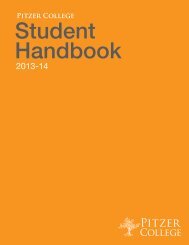

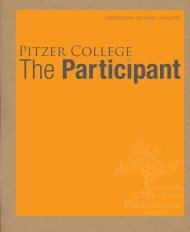
![Anticipated Courses SP14 [pdf] - Pomona College](https://img.yumpu.com/25363335/1/190x245/anticipated-courses-sp14-pdf-pomona-college.jpg?quality=85)

